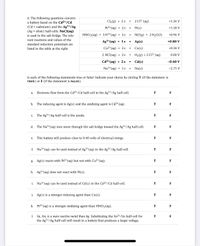
Introduction to Chemical Engineering Thermodynamics
8th Edition
ISBN: 9781259696527
Author: J.M. Smith Termodinamica en ingenieria quimica, Hendrick C Van Ness, Michael Abbott, Mark Swihart
Publisher: McGraw-Hill Education
expand_more
expand_more
format_list_bulleted
Concept explainers
Question
E-h please

Transcribed Image Text:6. The following questions concern
a battery based on the Cd²+/Cd
(Cd = cadmium) and the Ag1+/Ag
(Ag = silver) half-cells. NaCl(aq)
is used in the salt bridge. The rele-
Cl2(g) + 2 e
2 Cl1-(aq)
+1.36 V
Pt2+(aq) + 2 e
Pt(s)
+1.18 V
HNO3(aq) + з н1+ (ад) + 3е
NO(8) + 2 H2O(1)
+0.96 V
vant reactions and values of the
Ag1+(aq) + 1e
Ag(s)
+0.80 V
%3D
standard reduction potentials are
listed in the table at the right.
Cu2+(aq) + 2 e
Cu(s)
+0.34 V
2 HCI(aд) + 2 е
H2(g) + 2 Cl1-(aq)
0.00 V
Cd2+(aq) + 2 e
Cd(s)
-0.40 V
%3D
Na1+(aq) + 1e
Na(s)
-2.71 V
Is each of the following statements true or false? Indicate your choice by circling T (if the statement is
TRUE) or F (if the statement is FALSE).
Electrons flow from the Cd2+/Cd half-cell to the Ag1+/Ag half-cell.
F
а.
b.
The reducing agent is Ag(s) and the oxidizing agent is Cd2+(aq).
T
F
C.
The Ag1+/Ag half-cell is the anode.
T
F
d.
The Na1+(aq) ions move through the salt bridge toward the Ag1+/Ag half-cell.
T
F
е.
This battery will produce close to 0.40 volts of electrical energy.
T
F
f. Na1+(aq) can be used instead of Ag1+(aq) in the Ag1+/Ag half-cell.
F
g. Ag(s) reacts with Pt2+(aq) but not with Cu2+(aq).
T
F
h.
Ag1+(aq) does not react with Pt(s).
T
F
i. Nal+(aq) can be used instead of Cd(s) in the Cd2+/Cd half-cell.
T
F
j. Ag(s) is a stronger reducing agent than Cu(s).
T
F
k. Pt2+(aq) is a stronger oxidizing agent than HNO3(aq).
T
F
1. Sn, tin, is a more reactive metal than Ag. Substituting the Sn2+/Sn half-cell for
the Ag1+/Ag half-cell will result in a battery that produces a larger voltage.
F
Expert Solution
This question has been solved!
Explore an expertly crafted, step-by-step solution for a thorough understanding of key concepts.
Step by stepSolved in 4 steps

Knowledge Booster
Learn more about
Need a deep-dive on the concept behind this application? Look no further. Learn more about this topic, chemical-engineering and related others by exploring similar questions and additional content below.Similar questions
- Solve the percent error columnarrow_forwardcan you explain how you interpolated and show the steps?arrow_forwardAssuming zero reading is indeed zero, what is the reading of the micrometer reading? Assuming least count is 0.01mm. Choose the best answer. O 5 10 35 30 IIIIII 25 13.80 mm 13.30 mm O 12.80 mm O 14.10 mmarrow_forward
arrow_back_ios
arrow_forward_ios
Recommended textbooks for you
 Introduction to Chemical Engineering Thermodynami...Chemical EngineeringISBN:9781259696527Author:J.M. Smith Termodinamica en ingenieria quimica, Hendrick C Van Ness, Michael Abbott, Mark SwihartPublisher:McGraw-Hill Education
Introduction to Chemical Engineering Thermodynami...Chemical EngineeringISBN:9781259696527Author:J.M. Smith Termodinamica en ingenieria quimica, Hendrick C Van Ness, Michael Abbott, Mark SwihartPublisher:McGraw-Hill Education Elementary Principles of Chemical Processes, Bind...Chemical EngineeringISBN:9781118431221Author:Richard M. Felder, Ronald W. Rousseau, Lisa G. BullardPublisher:WILEY
Elementary Principles of Chemical Processes, Bind...Chemical EngineeringISBN:9781118431221Author:Richard M. Felder, Ronald W. Rousseau, Lisa G. BullardPublisher:WILEY Elements of Chemical Reaction Engineering (5th Ed...Chemical EngineeringISBN:9780133887518Author:H. Scott FoglerPublisher:Prentice Hall
Elements of Chemical Reaction Engineering (5th Ed...Chemical EngineeringISBN:9780133887518Author:H. Scott FoglerPublisher:Prentice Hall
 Industrial Plastics: Theory and ApplicationsChemical EngineeringISBN:9781285061238Author:Lokensgard, ErikPublisher:Delmar Cengage Learning
Industrial Plastics: Theory and ApplicationsChemical EngineeringISBN:9781285061238Author:Lokensgard, ErikPublisher:Delmar Cengage Learning Unit Operations of Chemical EngineeringChemical EngineeringISBN:9780072848236Author:Warren McCabe, Julian C. Smith, Peter HarriottPublisher:McGraw-Hill Companies, The
Unit Operations of Chemical EngineeringChemical EngineeringISBN:9780072848236Author:Warren McCabe, Julian C. Smith, Peter HarriottPublisher:McGraw-Hill Companies, The

Introduction to Chemical Engineering Thermodynami...
Chemical Engineering
ISBN:9781259696527
Author:J.M. Smith Termodinamica en ingenieria quimica, Hendrick C Van Ness, Michael Abbott, Mark Swihart
Publisher:McGraw-Hill Education

Elementary Principles of Chemical Processes, Bind...
Chemical Engineering
ISBN:9781118431221
Author:Richard M. Felder, Ronald W. Rousseau, Lisa G. Bullard
Publisher:WILEY

Elements of Chemical Reaction Engineering (5th Ed...
Chemical Engineering
ISBN:9780133887518
Author:H. Scott Fogler
Publisher:Prentice Hall


Industrial Plastics: Theory and Applications
Chemical Engineering
ISBN:9781285061238
Author:Lokensgard, Erik
Publisher:Delmar Cengage Learning

Unit Operations of Chemical Engineering
Chemical Engineering
ISBN:9780072848236
Author:Warren McCabe, Julian C. Smith, Peter Harriott
Publisher:McGraw-Hill Companies, The